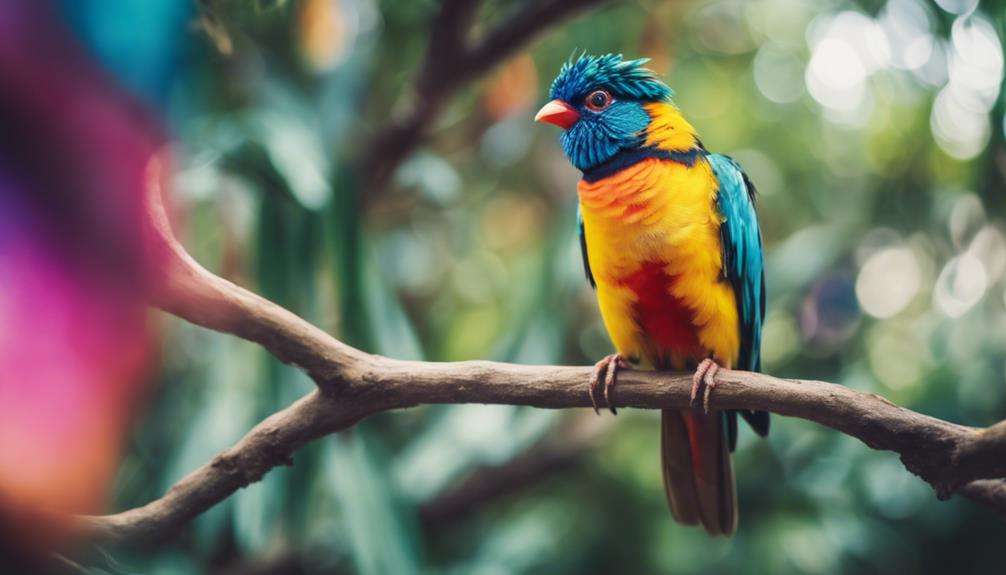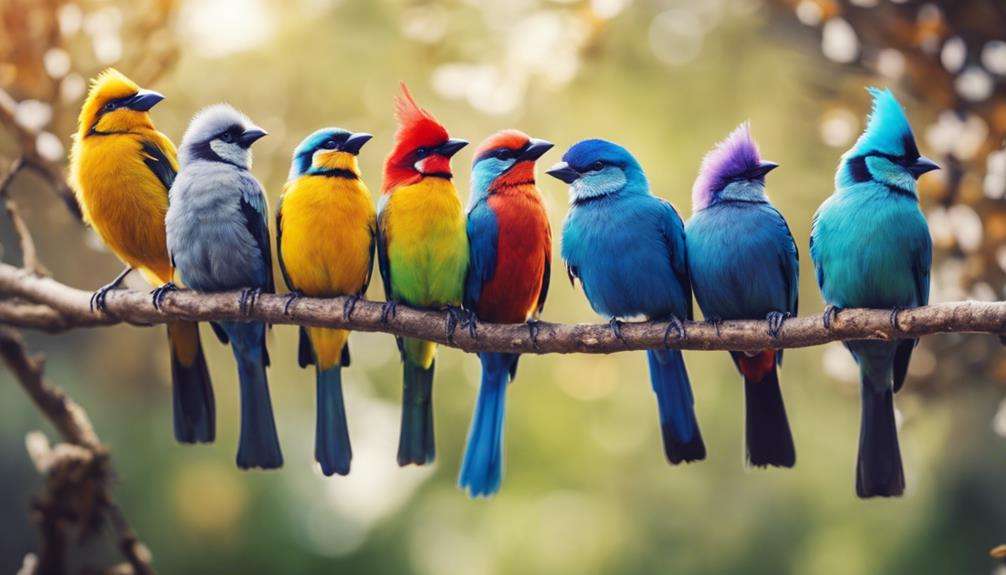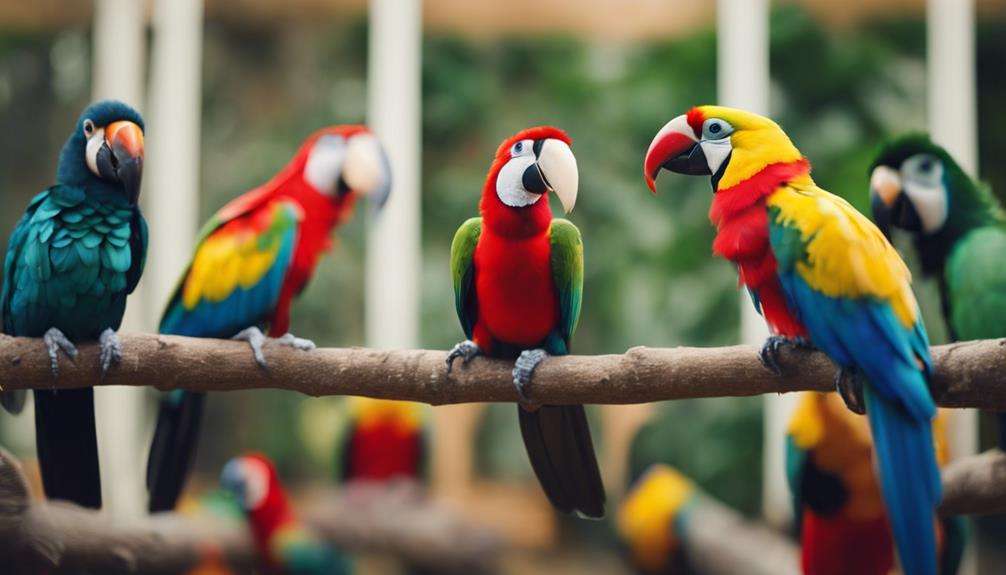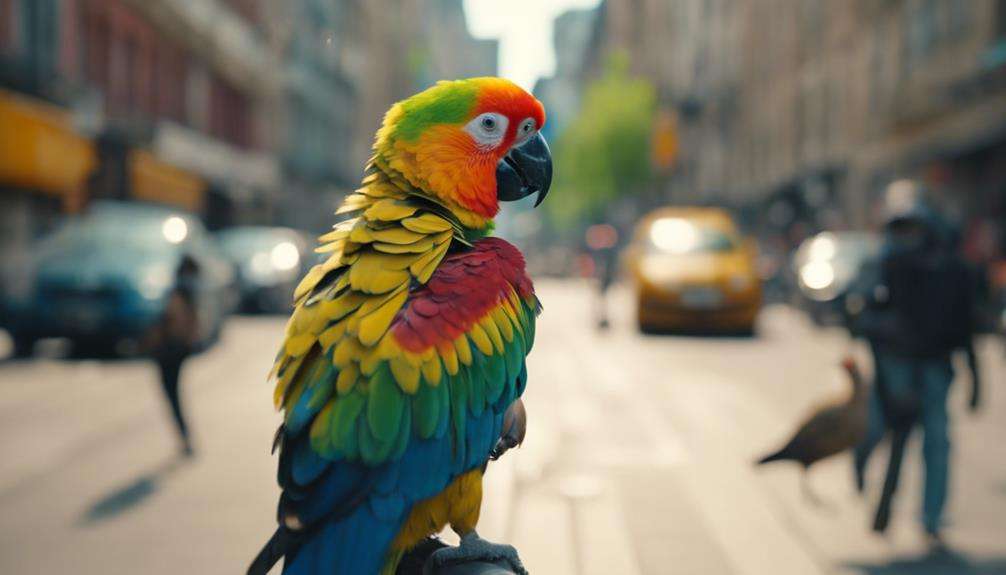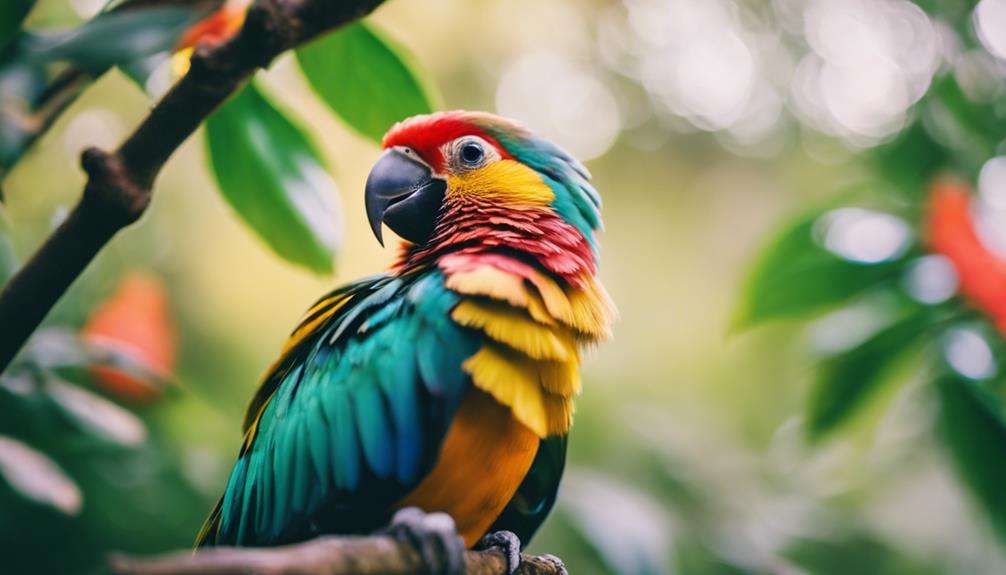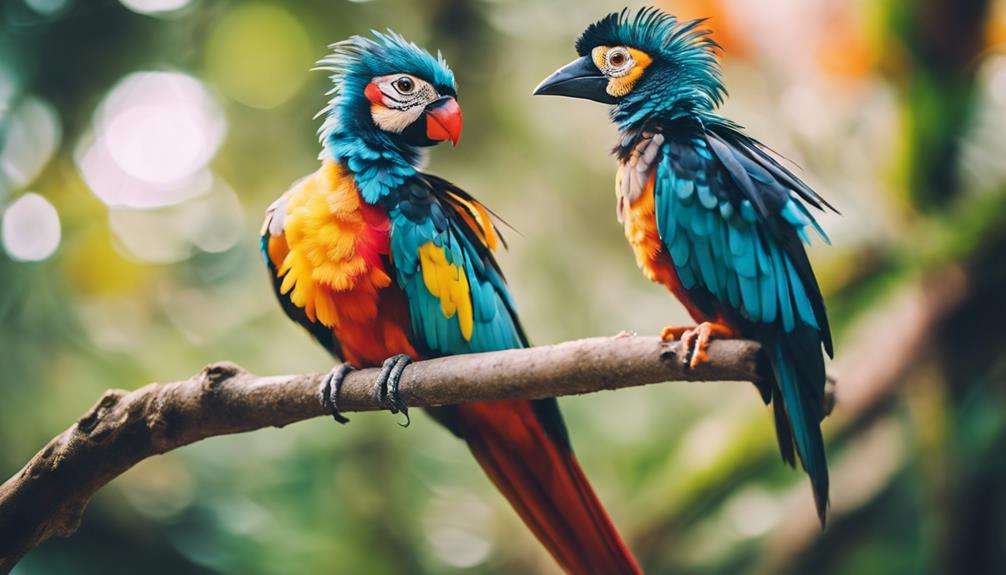Are you curious about birds that possess truly unique characteristics that make them stand out in the avian world?
From vibrant colors to impressive sizes, these avian wonders have features that captivate both bird enthusiasts and casual observers alike.
Explore the fascinating world of these feathered creatures and discover what makes them truly remarkable.
Key Takeaways
- Colorful Macaws and Majestic Peacocks exhibit vibrant plumage for courtship and social bonds.
- Elegant Flamingos display synchronized movements and use pink coloration for defense and mating rituals.
- Unique Shoebills and Impressive Secretary Birds showcase impressive physical characteristics and specialized feeding adaptations.
- Vibrant Bee-eaters demonstrate acrobatic hunting techniques with long, slender bills and stunning colorful plumage.
Colorful Macaws
Boasting vibrant plumage and impressive sizes, Colorful Macaws stand out as captivating avian creatures in the tropical forests of South America. These majestic birds are renowned for their striking colors, ranging from scarlet red to royal blue and gold, creating a spectacle against the lush green backdrop of the rainforest. Their large size and strong beaks not only aid in cracking nuts and seeds but also contribute to their commanding presence in the wild.
Highly social and intelligent, macaws thrive on interaction and mental stimulation. Their playful personalities make them delightful companions, engaging in various activities that challenge their cognitive abilities. With a lifespan of up to 50-60 years under proper care, these feathered beauties form strong bonds with their flock members, displaying intricate social behaviors and communication through loud vocalizations.
Majestic Peacocks
Peacocks, with their vibrant and iridescent plumage, are striking avian specimens known for their long, colorful tail feathers that play a crucial role in courtship displays. These majestic birds, native to South Asia, captivate onlookers with the intricate 'eye' patterns adorning their tail feathers, which serve the dual purpose of attracting mates and deterring predators.
The male peacock's tail feathers can reach up to an impressive 5 feet in length, showcasing a mesmerizing display of colors and patterns during courtship rituals. As the male of the species, peacocks use their extravagant plumage to court peahens, the female counterparts that lack the ornate tails but possess a subtle beauty of their own.
When a peacock fans out its tail, the iridescent hues and unique patterns create a spectacle that's both visually stunning and biologically strategic, ensuring the continuation of their species through successful mating endeavors.
Elegant Flamingos
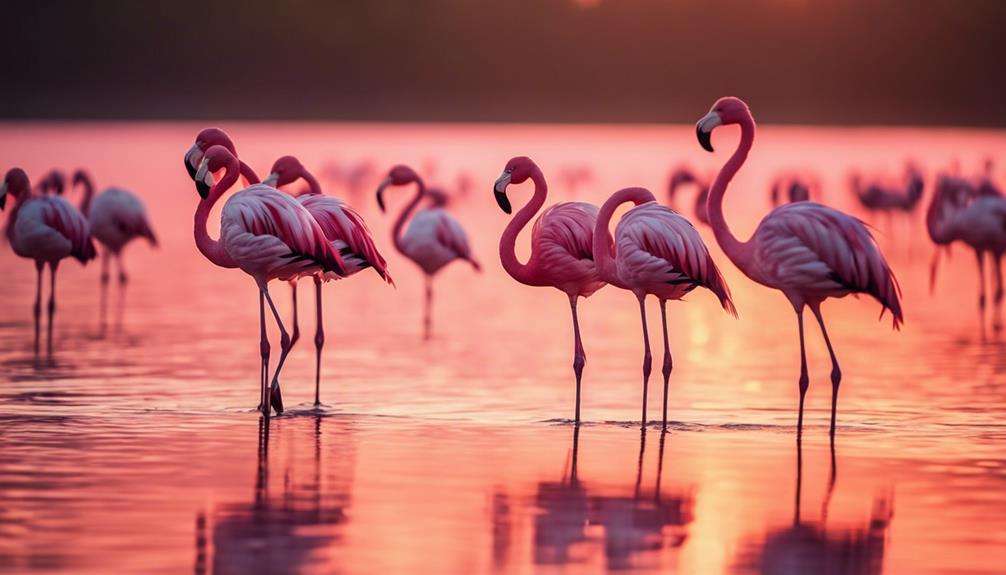
Elegant flamingos are renowned for their stunning pink plumage, a result of their diet rich in carotenoid pigments. Their long, slender necks and legs contribute to their gracefully unique S-shaped posture when standing.
These social birds often gather in large flocks, displaying synchronized movements and engaging in specialized filter-feeding behaviors.
Pink Plumage Beauty
Flamingos exhibit a striking pink plumage that's a direct result of their specialized diet rich in carotenoid pigments sourced from brine shrimp and blue-green algae. These vibrant hues aren't just for display; they're a product of a fascinating chemical reaction within the flamingos' bodies. Here's what makes their pink plumage so captivating:
- The pink coloration of flamingos is a result of the carotenoid pigments found in their food sources.
- A higher intake of carotenoids leads to a more intense and brighter pink plumage in flamingos.
- This unique pink coloration serves as both a defense mechanism against predators and a crucial element in their intricate mating rituals.
The beauty of flamingos truly lies in their natural adornment of pink feathers.
Unique S-Shaped Neck
Have you ever observed the remarkable flexibility of the neck in these elegant birds, enabling them to feed with precision in water while maintaining their heads upright?
Flamingos possess a unique S-shaped neck that facilitates their filter-feeding behavior on small organisms such as algae, shrimp, and insects. This specialized neck structure allows flamingos to reach deep into the water without submerging their bodies entirely.
Striking Toucans
You've likely marveled at the brightly colored beaks of toucans, which not only serve as a visual spectacle but also play a crucial role in their unique vocalizations.
These striking bills aren't just for show; they're specialized tools that enable toucans to communicate effectively within the dense rainforest environment.
Observing these birds in action offers a fascinating glimpse into the intricate ways in which they use their distinctive features.
Brightly Colored Beaks
With their vibrant and oversized bills adorned with a striking array of colors, toucans stand out as remarkable birds known for their distinctive features. These brightly colored beaks serve a dual purpose, both functional and visually appealing.
Here are some key facts about toucans' specialized beaks:
- Toucans boast beaks that come in hues of orange, red, yellow, and black, aiding in their recognition and attraction of potential mates.
- The lightweight nature of the toucan's beak, owing to its hollow structure, allows for agile movement and precise feeding on fruits and insects.
- These specialized beaks aren't merely ornamental; they play a crucial role in the bird's feeding habits, enabling them to grasp and manipulate food with exceptional accuracy.
Unique Vocalizations
Toucans exhibit a diverse range of unique vocalizations that encompass croaks, rattles, yelps, and even frog-like calls, adding to their distinctive charm and communicative prowess within their social groups. These vocalizations serve crucial roles in establishing territories and maintaining social bonds.
Toucans are capable of producing an array of sounds, from low guttural noises to high-pitched calls, which capture the attention of those around them. The clicks, clucks, and soft purring sounds in their vocal repertoire contribute to their captivating nature. By using this varied vocal range, toucans effectively convey messages and warnings to others in their community, showcasing the complexity and significance of their communication skills.
Unique Shoebills
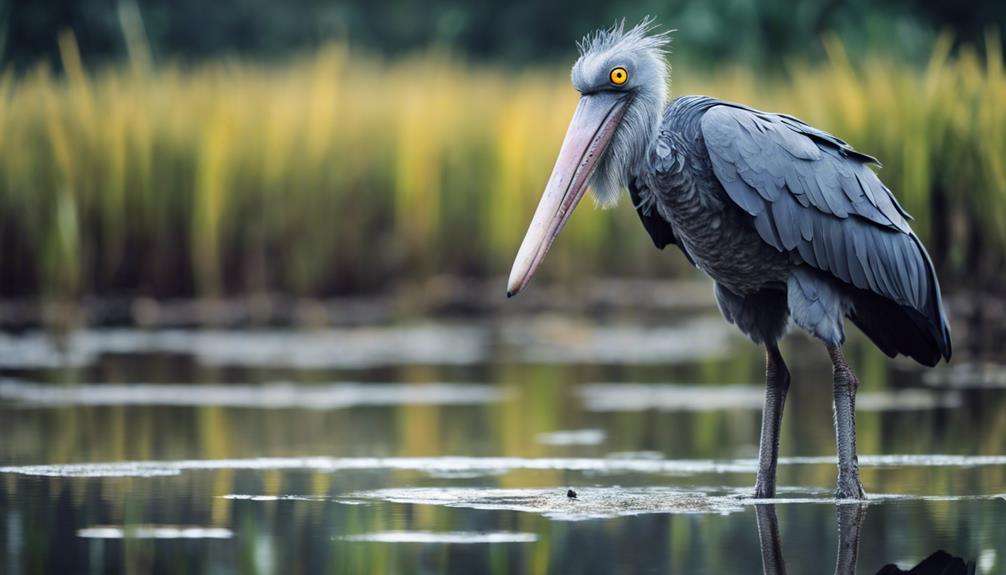
Shoebills, characterized by their large size and distinctive shoe-shaped bill, are captivating avian species native to the swamps of East-Central Africa. These prehistoric-looking birds exhibit a unique hunting technique, where they stand still for hours, waiting to strike at their prey with precision. Here are some fascinating facts about these remarkable creatures:
- Impressive Size: Shoebills are among the largest bird species, with heights reaching up to 5 feet and a wingspan spanning from 7.7 to 8.6 feet.
- Solitary Nature: Known for their solitary behavior, shoebills prefer to hunt and dwell alone in the dense marshes and swamps where they reside.
- Vulnerable Species: Despite their grandeur, shoebills are classified as vulnerable due to factors such as habitat loss, hunting, and disturbances. Their rarity in the wild makes spotting these majestic birds a truly special experience for bird enthusiasts and researchers alike.
Exotic Hoatzins
Exhibiting a striking blue face, maroon plumage, and spiky head crests, the exotic Hoatzins are unique avian creatures found predominantly in the swamps and forests of South America. These exotic birds possess a specialized digestive system with a multi-chambered stomach akin to that of a cow, enabling them to efficiently ferment food. This process gives rise to their strong odor, a characteristic feature of the Hoatzins.
Renowned for their excellent climbing abilities, they sport claws on their wings as chicks, aiding in their navigation through trees and branches.
In South America, Hoatzins are often spotted living in small family groups, emitting loud calls to communicate within their social circle. Their blue faces and maroon plumage make them easily distinguishable amidst the lush greenery of their habitat. Observing these birds in their natural environment provides a glimpse into the fascinating adaptations that have allowed the Hoatzins to thrive in their unique ecological niche.
Vibrant Bee-eaters
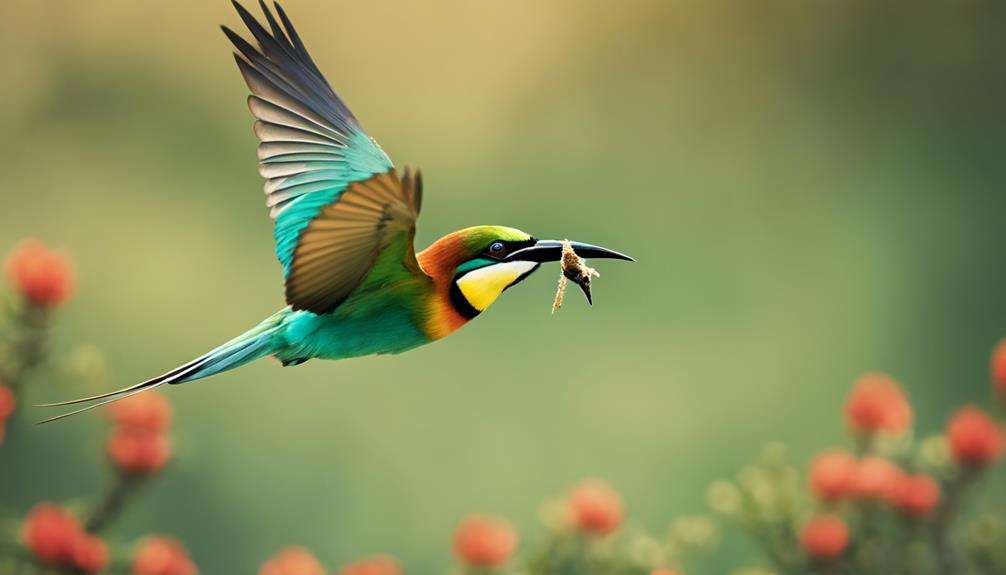
As you observe vibrant bee-eaters, pay close attention to their colorful plumage, which often consists of striking green, blue, and yellow feathers.
Their long, slender bills are precisely adapted for catching insects in mid-air, showcasing their remarkable hunting skills.
These birds perform acrobatic aerial displays while hunting bees, wasps, dragonflies, and other flying insects, demonstrating their agility and precision in capturing prey.
Colorful Plumage
Vibrant bee-eaters showcase a stunning array of bright greens, blues, yellows, and chestnut browns in their plumage, reflecting their unique adaptation for catching insects in mid-air with their long, slender bills. These striking colors serve both functional and aesthetic purposes, aiding in camouflage and attracting mates.
The vibrant hues also play a role in communication within their social groups, where displays of color can convey dominance or readiness to mate. Observing these colorful bee-eaters in open woodlands, one can witness their aerial acrobatics as they swoop and dart to catch flying insects.
Their popularity among bird watchers stems not only from their beautiful plumage but also from their fascinating behaviors and graceful flight patterns.
Long, Slender Bills
With their elongated bills perfectly adapted for capturing insects in flight, the vibrant bee-eaters exhibit a remarkable blend of precision and agility in their hunting techniques. These birds, adorned with distinctive colors like green, blue, and red, are commonly found in tropical regions where they showcase their agile flight and hunting prowess.
Vibrant Bee-eaters are skilled hunters, often perching on branches before swiftly darting to catch prey with their sharp bills. They're highly social creatures, forming noisy colonies where they engage in intricate aerial acrobatics during courtship displays. Their slender bills not only aid in capturing insects but also contribute to their overall graceful appearance and efficiency in securing food while in flight.
Quirky Kakapos
Kakapos, with their distinctive moss-green plumage and owl-like countenance, captivate observers with their quirky charm. These large, flightless parrots from New Zealand exhibit a fascinating array of behaviors and characteristics that make them truly unique in the avian world.
- Nocturnal Wonders: Kakapos are nocturnal birds, which means they're most active during the night. Their adaptation to the darkness contributes to their elusive nature and adds to their mysterious allure.
- Booming Mating Rituals: During mating season, male kakapos gather in specific locations to create loud 'booms' using a specialized thoracic air sac. These calls can be heard over long distances and play a crucial role in attracting females for breeding.
- Endearing Personalities: Despite their critically endangered status, kakapos are known for their quirky personalities and friendly demeanor. They display a remarkable level of trust and curiosity towards humans, making them a joy to interact with for researchers and conservationists alike.
Impressive Secretary Birds

Distinctive in both appearance and hunting prowess, the impressive Secretary Birds of sub-Saharan Africa stand out as formidable predators in their terrestrial habitats. These large, terrestrial birds can reach heights of up to 4 feet, showcasing a unique look with their long legs, crested feathers atop their heads, and a hooked bill ideal for hunting. Secretary birds are known for their powerful legs, which they use to stomp on prey like small mammals, reptiles, and insects.
Typically found either solitary or in pairs, Secretary Birds nest in trees and construct sizable stick nests for breeding purposes. When it comes to hunting, these birds are agile predators, relying on their skill and precision to catch prey on the ground with swift strikes. Their ability to swiftly and accurately capture prey showcases their exceptional hunting capabilities. In the vast savannas of sub-Saharan Africa, these Secretary Birds reign supreme as skilled and efficient predators.
Distinctive Spoonbills
Spoonbills, recognizable for their distinctive spoon-shaped bills, are wading birds known for their vibrant plumage and unique feeding behavior. These long bills aren't just for show; they serve a crucial purpose in helping spoonbills filter food from the water effectively. The vibrant pink plumage of spoonbills adds a splash of color to their surroundings, with some species showcasing additional white, yellow, or red markings for variation.
In their natural habitats, which include freshwater marshes, swamps, and coastal areas, spoonbills exhibit their unique feeding behavior. They can be observed sweeping their bills from side to side in shallow waters to catch prey efficiently. Additionally, these social birds are often spotted in large flocks during breeding periods, creating a mesmerizing sight for bird watchers. Whether in freshwater or saltwater environments, spoonbills continue to captivate with their striking appearance and fascinating feeding techniques.
Frequently Asked Questions
Which Bird Has the Most Beautiful Features?
When it comes to birds with beautiful features, the Hyacinth Macaw stands out with its stunning cobalt blue plumage. The contrast against the greenery is mesmerizing, making them a sight to behold in their natural habitat.
What Is the Most Distinguishing Feature of Birds?
Feathers, the most distinguishing feature of birds, exhibit a kaleidoscope of colors and patterns. They provide insulation and aid in flight. Beak shapes, wing spans, and tail lengths vary, alongside eye colors, foot sizes, song patterns, nest-building, migration routes, and courtship dances.
What Is the Most Unique Bird?
The Hyacinth Macaw stands out as the most unique bird with its stunning cobalt blue plumage, impressive wingspan, and vibrant eye color. Its distinctive calls, intricate songs, and elaborate mating rituals make it a remarkable avian species.
What Is the Most Unique Feature of a Bird?
Flying is the most unique feature of a bird. Their ability to soar through the skies is unparalleled. Birds' specialized bodies, with lightweight bones, powerful muscles, and intricate feathers, are perfectly designed for achieving the marvel of flight.
Conclusion
As you reflect on the diverse array of birds with distinctive features, you realize that each species offers a unique glimpse into the wonders of the avian world.
From the vibrant colors of Macaws to the majestic presence of Peacocks, every bird showcases the beauty and complexity of nature.
So next time you see a bird soaring through the sky, remember the intricate details that make them so fascinating, like a time traveler marveling at a prehistoric relic.

